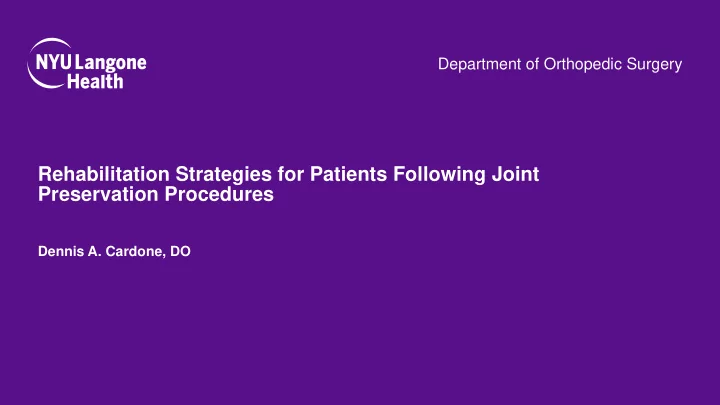

Department of Orthopedic Surgery Rehabilitation Strategies for Patients Following Joint Preservation Procedures Dennis A. Cardone, DO
Disclosure • Chief Medical Officer, New York City Public High School Athletics (PSAL) Division of Sports Medicine 2 Department of Orthopedic Surgery
Reference Division of Sports Medicine 3 Department of Orthopedic Surgery
Hip Preservation Procedures • Periacetabular osteotomy • Proximal femoral osteotomy • Cartilage restoration • Surgical dislocation • Adjuvant arthroscopy • Orthobiologics Division of Sports Medicine 4 Department of Orthopedic Surgery
Rehabilitation for Hip Preservation Procedures Challenges and considerations • Severity of intra-articular hip disease • Technical strategies of the surgical reconstruction • Muscular strength and compensation patterns Post-operative rehabilitation: • Functional outcomes • Patient satisfaction Division of Sports Medicine 5 Department of Orthopedic Surgery
Rehabilitation Goals: • Establishing an environment of protection and progressive motion • Minimize atrophy • Minimize joint stiffness • Protect bone and cartilage healing • Restore proper gait mechanics Division of Sports Medicine 6 Department of Orthopedic Surgery
Rehabilitation Progressive weightbearing Foot flat touchdown weightbearing (10-20 lbs of weight) Crutches • Preferred assistive device • Less likely to abduct and externally rotate femur • More physiologic compared to a walker Division of Sports Medicine 7 Department of Orthopedic Surgery
Rehabilitation Non-weightbearing can be a problem… • Decrease bone density • Delays in bony union • May accelerate proteoglycan degradation • May increase demand placed on abductors / ITB • Studies: even with NWB there is minimum 2.5x body weight on femoral head • Risk of iliopsoas and proximal rectus tendonitis • Prolonged functional deficits Division of Sports Medicine 8 Department of Orthopedic Surgery
Rehabilitation Prehab: • Psychological benefit • Patient satisfaction • Lower BMI • Screen for non-committed patients • Improved outcomes? Division of Sports Medicine 9 Department of Orthopedic Surgery
Rehabilitation following Joint Preservation Procedures • Patient age • History • Procedure • Psychological preparedness • Level of sports / activity Division of Sports Medicine 10 Department of Orthopedic Surgery
Division of Sports Medicine 11 Department of Orthopedic Surgery
Postoperative Phases Phase I (24 hours – 4 to 6 weeks) • Protection • Prevent stiffness • Pain • ROM • Passive • Gluteal isometrics • Prone lying • Stationary bike Division of Sports Medicine 12 Department of Orthopedic Surgery
Postoperative Phases Phase II (4 -6 weeks) Goals • Restore ROM • Reeducation of normal muscle firing patterns • Aquatic therapy • Progressive strength and endurance exercises • Weightbearing progression Division of Sports Medicine 13 Department of Orthopedic Surgery
Postoperative Phases Phase III Goals • Normal gait • Strength optimization • Muscle endurance • Driving Division of Sports Medicine 14 Department of Orthopedic Surgery
Postoperative Phases Phase IV Goals • Improve muscular endurance • Improve cardio fitness • Improve stability Division of Sports Medicine 15 Department of Orthopedic Surgery
Postoperative Phases Phase V Goals Return to sports • Type of sport: dependent on intraoperative pathology • Encouraging data to support return to high impact sports after open procedure • Functional rehab program with return to sports • Team decision • Patient, surgeon, rehab specialist • Modified or alternative sports / activities? Division of Sports Medicine 16 Department of Orthopedic Surgery
Postoperative Phases Phase V Evaluate for normal pelvo-femoral mechanics • Gait • Single-leg hop • Double-leg drop jump • Straight ahead jogging Minimum of 85% strength compared to contralateral side Sport-specific drills / tests Division of Sports Medicine 17 Department of Orthopedic Surgery
Summary Rehabilitation following Joint Preservation Procedures Consideration to • Particular surgical procedure • Patient expectations • Sport / activity Early rehabilitation and weightbearing Optimize functional outcome and patient satisfaction Division of Sports Medicine 18 Department of Orthopedic Surgery
Thank you Division of Sports Medicine 19 Department of Orthopedic Surgery
References • Adler, KL, et al. Current Concepts in Hip Preservation Surgery: Part II-Rehabilitation. Sports Health 2015 • Givens-Heiss DL, et al. In vivo acetabular contact pressures during rehabilitation, part I: postacute phabse. Phys Ther. 1992 • Vanwanseele B, et al. The effects of immobilization on the characteristics of articular cartilage: current concepts and future directions. Osteoarthritis Cartilage. 2002 • Kaku N, et al. Biomechanical study of load transfer of the pubic ramus due to pelvic inclination after hip joint surgery using a three dimensional finite element model. J Orthop Sci. 2004 • Youdas JW, et al. Partial weight-bearing gait using conventional assistive devices. Arch Phys Med Rehabil. 2005 • Stalzer S, et al. Rehabilitation following hip arthroscopy. Clin Sports Med. 2006 • Tippett SR. Returning to sports after periacetabular osteotomy for developmental dysplasia of the hip. N Am J Sports Phys Ther. 2006. • Novais EN, et al. Open surgical treatment of femoroacetabular impingement in adolescent athletes: preliminary report on improvement of physical activity level. J Pediatr Orthop. 2014 • Wilk KE, et al. Recent advances in the rehabilitation of isolated and combines anterior cruciate ligament injuries. Orthop Clin North Am. 2003 Division of Sports Medicine 20 Department of Orthopedic Surgery
Recommend
More recommend